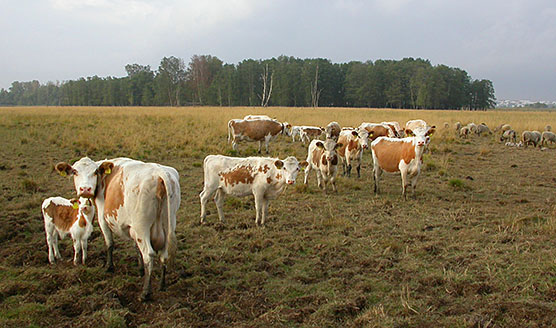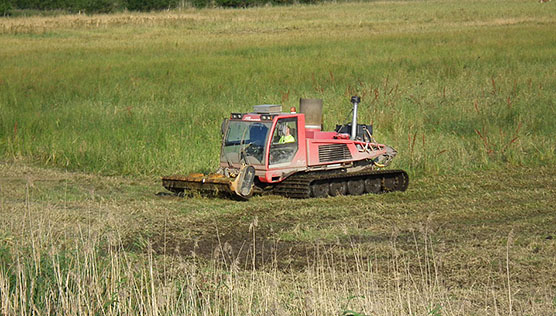Press release 2014-09-09 at 12:36

Grazing diversifies wetland habitats by making them more open. Photo: Markku Mikkola-Roos
The construction and restoration of wetlands can improve the living conditions of bird populations. According to a recent study, grazing is the single most important maintenance method for wetlands, due to its diversifying impact. This type of maintenance benefits waders in particular, as well as other birds living in wetlands. The poor condition of wetlands has led to the decline of wetland bird populations around the world. The establishment of a voluntary network of protected areas where hunting is prohibited could facilitate the autumn migration of young wetland birds in particular and balance the hunting pressure they face.
Wetlands are some of the most biodiverse environments in the world. They produce significant ecosystem services by maintaining diverse water bird populations and purifying run-off waters, for example. However, wetlands and their bird populations are globally threatened by intensified land use and the results of the degradation of water systems, such as overgrowth and eutrophication. Throughout the last century, the amount of wetlands has decreased by half globally, and the conditions of the remaining wetlands have worsened. The poor condition of wetlands has in turn led to the decline of wetland bird populations.
Finland is a member of the worldwide Ramsar Convention that protects wetlands. The convention obliges its members to establish nature reserves in wetland areas and promote the protection of internationally significant wetlands and waterbirds.
The Nordic Wetlands Day conference held in Helsinki on 1–2 September gathered together wetland experts to discuss the state of Finnish wetlands from the perspectives of game, water protection and biodiversity. The establishment and maintenance of wetland nature reserves not only benefits the species living in the wetlands, but also provides well-being and benefits to society as a whole. Addresses made by landowners also highlighted landscape, hunting and water protection values. The conference also included a number of treks, during which participants were introduced to the good practices of wetland construction and were given the opportunity to share their experiences on the practical realisation of wetland projects.
Maintenance of bird wetlands yields results
The impacts of the wetland maintenance programmes carried out in the wetlands of southern Finland on stopover and nesting bird populations were studied in 2004–2012. The study aimed to investigate the impacts of different programmes on bird populations. One of the main goals of the study was to provide an overview on the cost-effectiveness of different approaches and thus help determine how available resources should be directed.
“According to the study, cattle grazing is the single most important maintenance method due to its diversifying impact. These maintenance efforts benefit waders in particular, as well as other types of birds living in wetlands. The positive impacts on bird populations are due to increased space and the presence of cattle. These factors improve the feeding conditions and security of birds. Diving ducks and waterbirds that feed on fish benefited the least from these methods,” says Senior Researcher Markku Mikkola-Roos from the Finnish Environment Institute.
The study shows that maintenance can improve the conditions of declining wetland bird populations. Since the maintained sites are the best bird waters in southern Finland, the biological significance of the maintenance efforts is great. The positive impacts are not limited to Finland either, since the restoration benefits all birds that migrate to the north along the Gulf of Finland migration route – all the way to Siberia.

Harrowing is an effective method for restoring shorelines. Photo: Markku Mikkola-Roos
“One of the most important observations was that after maintenance efforts end, the wetland bird populations start to decline. Because of this, maintenance should continue so that the achieved benefits are not lost. In the future, extensive maintenance efforts should also be planned from the research perspective so that their impact could be studied more closely. In particular, it is important to find the means of improving the living conditions of diving ducks and birds that feed on fish,” says Senior Museum Technician Petteri Lehikoinen from the Finnish Museum of Natural History.
Finland needs a network of areas protected from hunting
The majority of the nature reserves established on private land that are included in the national bird wetland protection programme allow hunting. The beginning of the duck hunting season on 20 August triggers the autumn migration of young birds, since there are only a few areas in Finland where hunting is prohibited.
Finland’s preserved bird wetlands should be developed into a network of areas that are protected from hunting. In such reserves, young and old birds could prepare for the autumn migration in peace and hunting pressure would be more evenly balanced between young and old birds in the autumn. This way the most productive part of the population – older females – would have more time to prepare for the winter and next year’s breeding season. These restricted hunting areas would also serve as gathering places for other wetland birds. In addition, such a network of protected areas could support Flyway, or migration route conservation, as highlighted in international conventions.
“Landowners will play a key role when preserved bird wetlands are developed into a network of areas protected from hunting. Success hinges on their willingness to volunteer,” says Senior Inspector Matti Osara from the Ministry of the Environment.
The Ministry of the Environment aims to launch discussions regarding the development of the network of areas protected from hunting with the Ministry of Agriculture and Forestry, the Finnish Wildlife Agency and the Finnish Environment Institute.
More information
Senior Researcher Markku Mikkola-Roos, Finnish Environment Institute (SYKE),
tel. +358 (0)400 148 685, firstname.lastname@ymparisto.fi
Senior Museum Technician Petteri Lehikoinen, Finnish Museum of Natural History Luomus,
tel +358 (0)40 723 3383, firstname.lastname@helsinki.fi
Senior Inspector Matti Osara, Ministry of the Environment,
tel. +358 (0)295 250 216, firstname.lastname@ymparisto.fi
Links